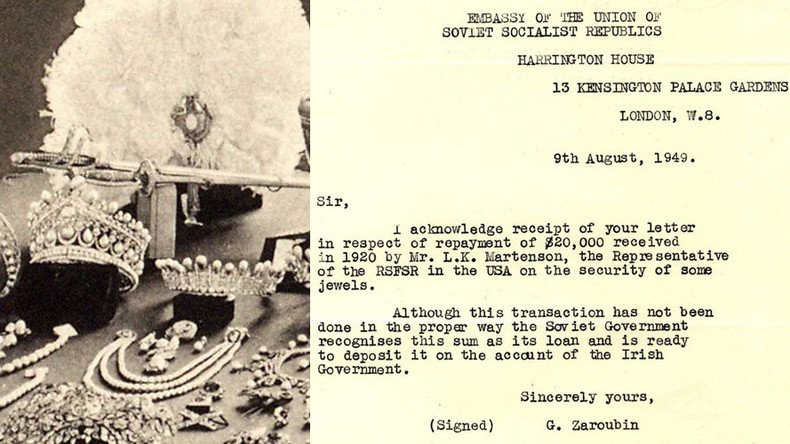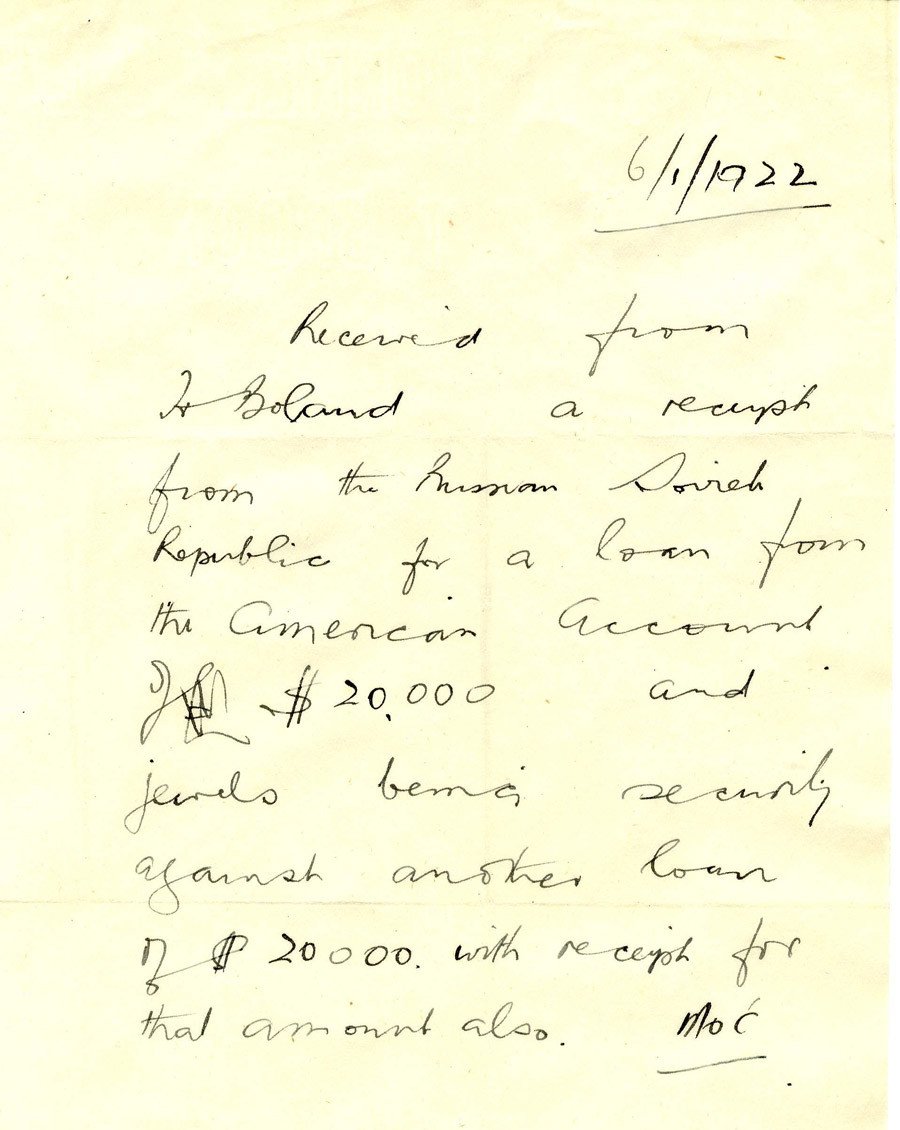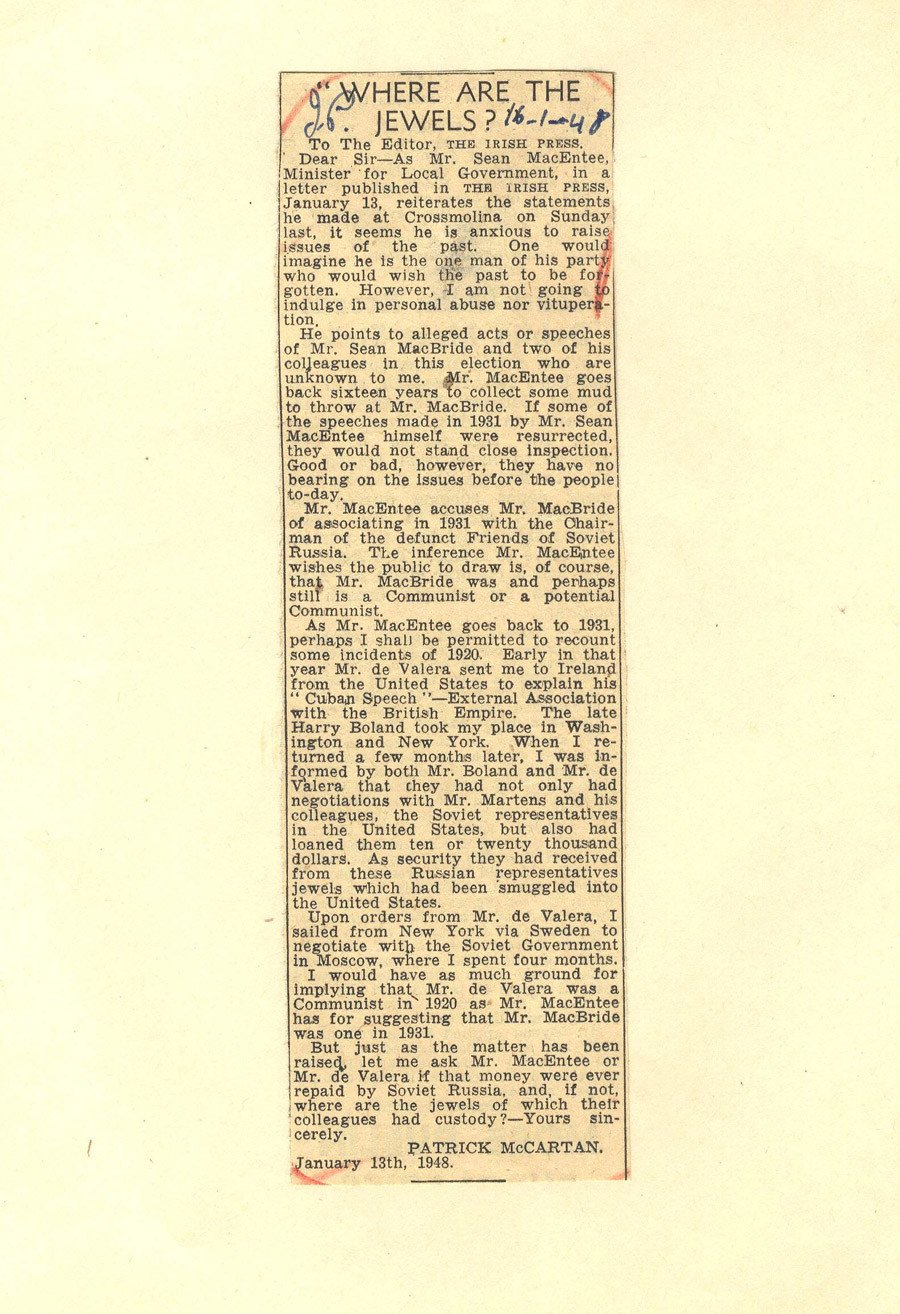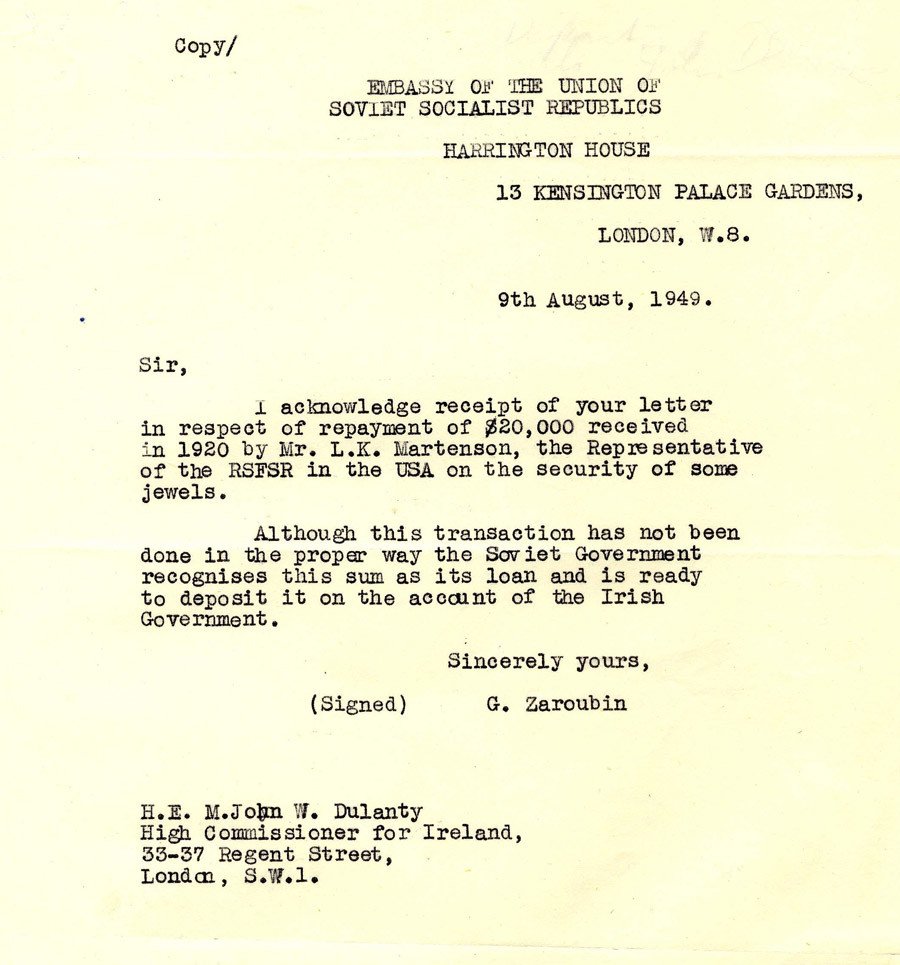'Pawnshop for the Bolsheviks': The crazy Irish adventures of Russia's crown jewels

Ireland marks 100 years since the 1916 Easter Rising this weekend, an event which changed the course of history not just for this tiny island, but reverberated around the world and inspired revolutionaries in Russia, India, and the US.
In Dublin City in 1913
The boss was boss and the employee the slave
The women worked and the child went hungry
-Donagh MacDonagh
Four years after the Rising, the two nascent nations of Soviet Russia and Ireland cut a secret loan deal - a selection of Russian crown jewels in exchange for US$20,000, the equivalent of $250,000 today.
It would take another three decades to get those jewels back home to Russia.
"Twas better to die 'neath an Irish sky
— Oulala Productions (@OulalaProd) September 28, 2013
Than at Suvla or Sud el Bar.
And from the plains of Royal Meath
Strong... http://t.co/JLGc3lxyDU
This Easter Rising version of the ancient Irish folk ballad “Foggy Dew” captures the conflict for young Irish soldiers at the time, preferring to wage their own war on their own soil for independence rather than invade Constantinople on behalf of the British Empire.
READ MORE: Easter Rising 100 Years On: Relatives of 1916 veterans honor Ireland's revolution
History books may depict Ireland and Russia as unlikely allies, but the two countries shared a common energy 100 years ago. Both were on the verge of revolution.
Whoever calls such a rebellion a "putsch" is either a hardened reactionary, or a doctrinaire hopelessly incapable of envisaging a social revolution as a living phenomenon.
-Vladimir Lenin
The Bolsheviks reflected on the significance of the Rising just a few months later in July 1916.
Brendan McGeever explores the links between Lenin, the Bolsheviks and the 1916 Easter Rising in Ireland. https://t.co/4PW6xMKhDm
— Alpha History (@alphahistory) March 25, 2016
Lenin defended its importance against those newspapers who called it a “putsch” in The Irish Rebellion of 1916, but he also regretted the timing: “It is the misfortune of the Irish that they rose prematurely, before the European revolt of the proletariat had had time to mature.”
Trotsky saw the Rising as the start of something bigger than Ireland in his text Lessons of the Events in Dublin.
“The historical role of the Irish proletariat is only beginning. Already it has brought its class anger against militarism and imperialism into this rising, under an out-of-date flag. This anger will not now subside. On the contrary, it will find echoes all over Britain,” wrote Trotsky.
They carried him up to the jail
— Jim McLaughlin (@ShamrockCelt45) April 15, 2011
They carried him up to the jail
They shot him down on a bright May morning
And quickly laid him in his gore
Immortalized in Patrick Galvin's poem, James Connolly stood out among those who were executed by the British just days after Easter. Born in Scotland of Irish parents, he was both a Marxist and an Irish nationalist - and saw the Rising as part of global workers struggle.
Twenty years later, Trotsky wrote to Connolly’s daughter Nora: “Since my early days I have got, through Marx and Engels, the greatest sympathy and esteem for the heroic struggle of the Irish for their independence. The revolutionary tradition of the national struggle is a precious good.”
Raise the scarlet standard high-'neath its folds we'll live&die.Though cowards flinch and traitors sneer,we'll keep the red flag flying here
— Luke Coleman (@littleletters) September 14, 2015
The Bolshevik Revolution was greeted with early enthusiasm in Ireland.
Thousands of Dubliners packed the Mansion House’s Round Room in February 1918 to raise an actual red flag, sing the ballad “The Red Flag”, and pass Cathal O’Shannon’s resolution that the “people of Dublin were at one with the Bolsheviks” and maintained “the Russian interpretation of the democratic principle was the only one that would be acceptable to the people of Ireland.”
In that same room less than a year later, the First Dáil Éireann (parliament) declared Ireland’s independence from imperialist Britain.
Countess Constance Markievicz was there for both events and, in between, she became the first woman ever elected to the British House of Commons. She never took her seat in protest, choosing instead to form the Irish republic’s first parliament.
“The Red Star” continues to be an anthem for the labor movement. It was first sang in the British House of Commons in 1945 after the Labour Party defeated Winston Churchill and more recently, Jeremy Corbyn sang it during his victory celebration as Labour Party leader.
He found it difficult to get American money and a loan was given to him by the Irish mission. In security for the loan, certain articles of jewellery were given up by him.
-Éamon de Valera
When Russian and Irish representatives met in New York in April 1920, they were on similar missions - in search of recognition and funding for their new republics.
Éamon de Valera, the only commandant of the Rising who wasn’t executed because he was born in New York City, raised more than $5 million during his US tour.
would that he stayed there@RTEArchives Éamon de Valera born in New York #OnThisDay 1882http://t.co/ph9x2x15zppic.twitter.com/VWnMUPOJMn
— Nic Halley (@NicHalley) October 14, 2015
Ludwig Martens, head of the Soviet Bureau in the US, had trouble getting dollar donations, so he cut a deal with his Irish counterparts.
Tiaras, necklaces, and other pieces made with gold, pearls, and diamonds were part of the recently-liberated collection of royal jewels, although the Imperial crown was not part of the deal.
Irish politician Harry Boland was with de Valera during negotiations and later was in charge of returning the Russian jewels safely to Ireland in 1922.

He initially offered the jewels to civil war icon Michael Collins, but the two argued and Collins told Boland to take them away.
A newspaper report from years later claimed to quote what Collins said during their argument: “I’m not going to bother with those things, they can’t help us with our cause at the moment.. I don’t want them. The Czar and his family have been killed. There’s blood on the jewels. Take them things away and look after them for the time being. We’ll decide about them later.”
Boland then brought them to one of the most secure places for valuables at the time - his mammy.
Kathleen Boland first kept the jewels on her person and managed to hide them during a raid by civil war soldiers, according to her son-in-law, Senator Sean O’Donovan.
When the heat died down, she kept the jewels in her basement at 15 Marino Crescent, the former home of Dracula author Bram Stoker.
Happy Birthday, Bram Stoker — born Nov 8, 1847 at 15 Marino Crescent, Clontarf, on the northside of Dublin, Ireland pic.twitter.com/dDopRPXdMf
— Bob Freeman (@OccultDetective) November 8, 2014
Harry Boland’s sister said it was her brother’s dying request that the jewels be given to de Valera once he came into power, a request she fulfilled in 1932.
The jewels were kept in government buildings for the next seventeen years. James McElligott, secretary of the Department of Finance during that period, told a newspaper they were kept in his unlocked drawer.
The mere act of recognizing our Government would have a great effect on the morale of our own people and was certain to have effect all over the world. The people of the world recognized the Soviet Government as the Government of a great country though the Governments of the world withheld that recognition. Recognition of Ireland would make every genuine sympathiser with Ireland an active advocate of recognition of the Soviet Government.
-Patrick McCartan
Irish politician Patrick McCartan was sent to Russia on a secret mission in 1921, after the loan was made, with the aim of securing Russian recognition of the Republic of Ireland.
McCartan had previously been involved with negotiating a treaty between the two countries, but when he arrived in Moscow in February 1921, he found conditions had changed.
@PatsyMcGarryIT but he did reportedly consider sending Patrick McCartan in 1920
— Colm Ó Mongáin (@colmomongain) July 11, 2015
“(Foreign Minister Litvinov) intimated that the Agreement then being negotiated with England would make it difficult at that moment for them to do anything for us,” he wrote in his Memorandum by Patrick McCartan on hopes of recognition of the Irish Republic from the USSR.
“It was apparent from both Mr. Litvinov and Mr. Nuratova that the Agreement with England was of the utmost importance,” he concluded.
One month later on St. Patrick’s Day, the Anglo-Soviet Trade agreement was signed, marking the first treaty between Russia and the UK.
McCartan was told after the British agreement was signed that his contact Nuratova was in a sanatorium for a rest, only to find out later that he was in a prison.
Despite this setback, Soviet Russia was still the only country to negotiate with the self-proclaimed Irish Republic between 1919 and 1922, albeit in secret.
The Irish Republic sent a delegation to the Paris Peace Conference in 1919, but were not admitted.
Today 1919 – Dáil send letter to Paris Peace Conference, repudiating Britain’s claim to speak for Ireland. https://t.co/RCYyKXVCvz
— Brian John Spencer (@brianjohnspencr) May 17, 2015
The securities are safe in Government keeping, awaiting the day of possible redemption. So far as I know there was never any effort made to realize them or get an expert estimate of their value.
-Éamon de Valera
27 years later during the 1948 general election campaign, McCartan publicly asked de Valera “Where are the jewels?”, de Valera came clean about the deal during an election speech, admitting the loan had never been repaid.

A local councillor from the county of Monaghan said de Valera’s party Fianna Fáil had made Ireland “a pawnshop for the Bolsheviks”.
The London auction house Christies appraised the jewels in 1949 to be worth £1,600, far less than the $20,000 loan.
The keeper of the jewels, James McElligott, wanted Christies to sell them without revealing their history, but only after informing the Soviet government of the plan.
Negotiations between both governments started in March of 1949 and the jewels were returned to their homeland in September through the Irish High Commissioner in London for repayment of the original $20,000 loan.

The money was lodged to the Irish Exchequer the following year, ending a curious chapter of history largely forgotten by both countries.
The jewels are currently on display in the Moscow Kremlin Armory State Diamond Fund.












